How to use a gas cylinder in your home: instructions + valuable tips
Do you think that the lack of gas in the village is a serious reason to refuse to use blue fuel? Agree that even in the absence of a gas main, it is always possible to organize the work of a gas stove, heater or column. It is enough to purchase and refuel a household gas cylinder to feel all the benefits of civilization.
We will talk about the existing types of cylinders, about how to use a gas cylinder correctly in everyday life. The article we have proposed describes in detail how to connect equipment and refuel an empty cylinder.
Scary news about household gas explosions is increasingly heard from television screens. We list all safety measures for the operation of gas equipment. Knowing the requirements, it will be possible to use gas cylinders without fear and not worry about your life, health and the lives of loved ones.
The content of the article:
Types of household gas cylinders
The vast majority of household gas cylinders are used to organize the operation of stoves. Therefore, this review will be devoted to just such a method of operation.
By the type of material used, gas cylinders are:
- Steel;
- Polymer-composite;
- Metal composite.
The most common were steel (metal) cylinders. It was with them that the era of mobile gasification began.
Despite the numerous shortcomings (heavy weight, insecurity, susceptibility to corrosion, opacity), these cylinders are in great demand due to their availability and low price.

Polymer-composite cylinders are lighter than steel by 35-40%, because for their manufacture, fiberglass coated with epoxy resin is used.Such cylinders are explosionproof and shockproof, which provides a protective casing.
They are not susceptible to corrosion, transparent, equipped with an overflow valve. True, they have a smaller volume than steel counterparts, and their price is an order of magnitude higher.

Metal-composite cylinders are a cross between polymer-composite and steel. In terms of safety and impact resistance, they are inferior to polymer-composite products.
Advantages and disadvantages of gas cylinders
To answer the question of whether it is possible to use gas cylinders in everyday life, you need to deal with all their strengths and weaknesses. An autonomous gas cylinder is an indispensable thing in the absence of a centralized gas supply.
But it will not interfere with the economy and, so to speak, just in case of fire. After all, it often happens that the supply of gas is suspended for repair and maintenance work.
The main advantages of using gas in cylinders:
- Mobility - the tank can be transported, rearranged;
- Storage duration - a gas-filled cylinder can be stored for several years;
- Big choice - you can purchase a cylinder of various volumes.
The disadvantages are mainly related to the danger that may occur during connection and operation errors:
- Fire and explosion hazard. In the event of a sharp jump in temperature or fire, a metal can explode, causing significant damage to the home and the health of people who are in the explosion zone.
- Danger of breathing gas. Cylinders can let gas through, and a high concentration propane-butane mixture can kill people. This is possible in the event of a leak, when the cylinder is in the living area.
- Danger of abrupt rolling over. Due to a pressure surge, a sharp release of flame is possible, as a result of which gas equipment can be damaged.
When fulfilling the norms and rules for the operation of gas equipment, the risks from their use are minimized.
Safe operation of domestic gas cylinders
To understand how to safely use a gas cylinder, you need to dwell in more detail on their connection, installation, operation and refueling.
Connection of a gas cylinder to consumption devices
Not enough to have gas bottle and the device to which it will be connected.
Autonomous gasification involves the presence of a whole system of equipment:
- A device that will “feed” gas (stove, column, grill, etc.);
- Gas bottle;
- Gas hose;
- Gearbox;
- Hose clamps.
The pressure in the gas cylinder is temperature-dependent and variable. Therefore, to align it gas reducer, which not only lowers, but also equalizes the pressure to the value necessary for the normal operation of the equipment.

The gearbox is screwed onto the valve fitting and is connected to the gas consumption device using a hose. All threaded connections are pre-wound 3-4 layers of gas fum tape. The connecting hose at the fixing point must be additionally secured with steel clamps.

All joints should be checked for their tightness. The reliability of the connection is checked by applying soap foam - the presence of bubbles indicates a lack of tightness. To eliminate the leak, tighten the nut connecting the fitting to the gearbox with great effort.
If a gas leak is detected in the area of the connecting hose, then tighten the bolts of the clamps. After completing the adjustment, it is necessary to re-check with soap suds. Such a check should always be carried out when connecting a gas cylinder, both for the first time and after replacing it.
Some gas masters check for gas leaks with a lit match. This method of leak testing is prohibited by safety standards. Firstly - in daylight, small flames of flame can simply not be noticed. Secondly, a significant gas leak can lead to ignition and even explosion.
Safety requirements for the operation of gas cylinders
One of the most important safety criteria for the operation of a gas cylinder is the constant monitoring of overheating and possible leakage. By her own propane-butane mixture It is odorless, but the presence of a hydrocarbon-mercaptan can determine the leak.
Basic safety requirements for the operation of bottled gas:
- Equipment related to gas consumption must be operational. A technical examination of the cylinders should be carried out at least once every 5 years. When connecting a cylinder or replacing it, check the tightness of all connections with a soap solution.
- Do not use cylinders with traces of rust, with a faulty valve, in the absence of gas marking.
- Keep the cylinder in a special ventilated cabinet that protects the cylinder from direct sunlight and precipitation. The distance from the cabinet to the window or door should be at least 1 m.
- When placed indoors, the distance to the source with an open flame should be at least 5 m. Also, the distance to heat sources (heating radiators, electric heaters, etc.) should be at least 1 m. Large-capacity cylinders should be placed in a special cabinet with the outside of the housing.
- It is forbidden to store cylinders in the basement or to bury in the ground.
- In working condition, the cylinder should be upright.
- When replacing a cylinder, make sure that there are no sources of fire.
Never neglect the above rules for the safe operation of bottled gas, as even the slightest violation can be a life threat.
What to do when a gas leak is detected?
Gas leakage can be detected visually using soap suds. Most often, leakage occurs at fittings or hose connections.
Severe leakage can be determined by ear, at least this will serve as a hint for the place of application of the soap solution. Another factor to control leakage is the appearance of a characteristic odor.

The danger is that the propane-butane mixture is heavier than air, so when it leaks, the gas rushes to the floor, can accumulate under the floor or in the basement. One spark will be enough to provoke an explosion. The main cause of a gas explosion is most often negligence and neglect of safety standards.
To avoid the risk of carbon monoxide poisoning and to prevent the likelihood of an explosion, set yourself the following rules for using a gas cylinder in your home:
- Installation of gas detectors near the floor;
- Ventilate the room until the cylinder valve opens;
- The switched on gas appliances must be constantly monitored;
- Gas stoves must not be used for heating or space heating;
- Gas cylinders, like gas equipment, should only be repaired by specialists;
- With a long absence of tenants, gas cylinders should be moved outside the housing.
If, nevertheless, a gas leak occurs, it is forbidden to use any electrical appliances. You cannot perform actions that contribute to the formation of sparks.
If a leak is detected, the cylinder must be shut off immediately. gas cylinder valve, disconnect from gas-powered appliances and take it outside. Everything needs to be done quickly and accurately, since dropping the cylinder can cause it to catch fire.
If a gas leaks from a cylinder, it may cause ignition. The first step is to try to close the valve. In the case of a small flame, you can try to extinguish it with a wet towel, and then take the balloon out into the street. It is risky to extinguish a large flame, since the accumulated gas in the room can explode.
Remember that overheating a cylinder to 180 degrees can cause it to the explosion. While the gas is burning, the probability of an explosion is minimal; an explosion is possible if the cylinder overheats from objects burning nearby. Therefore, immediately after the fire, it is necessary to close the valve, remove the cylinder from the room and call the emergency service.
Features of the operation of gas cylinders
The liquefied gas in the cylinder is under pressure, and when it is supplied to gas equipment, it goes into a gaseous state.
This process is accompanied by a sharp decrease in temperature, and with intensive use of equipment, the temperature can drop to a critical value, at which further conversion will become impossible.
The simplest solution is to reduce gas consumption. You can also resort to additional heating of the cylinder, but it is forbidden to use heat sources with an open flame. Insulation of gas cylinders is not allowed, but it is possible to use special “heating shirts” and thermo-covers.
The owners of gas cylinders may encounter similar difficulties in the winter, if the cylinders are in an unheated room. In this case, it is best to use special propane-butane mixtures with different percentages of components.
The standard gas mixture for the warm season contains 60% butane, 40% propane. A winter mixture for critically low temperatures may contain 80% propane and 20% butane, but such a mixture is much more expensive.
Filling gas cylinders
It is recommended to refill domestic gas cylinders in specialized “gas-filling points”. In addition to observing the refueling norms, each tank is guaranteed to be checked for leaks, compliance with the service life, and the presence of sediment in the form of heavy fractions.
When refueling a propane-butane mixture, it must be taken into account that filling should be no more than 85%. Not every petrol station has the necessary shutoffs, and refueling is carried out by volume rather than weight, which is fraught with the appearance of increased pressure in the cylinder.
If you are sure that the cylinder is in good condition, the gasoline has been checked and removed, then refueling can also be done at gas stations.
However gas station permissible provided that the refueling process is not carried out according to the volume of blue fuel, but according to its weight, which is controlled by electronic scales.
Conclusions and useful video on the topic
Marking of technical inspection of household gas cylinders:
Safety rules for the operation of household propane-butane cylinders:
Requirements and rules for the operation of gas cylinders: myths and reality:
Gas cylinders are an integral attribute of any owner of a summer house or house whose housing is outside the centralized gas supply.
Compliance with the rules for connecting and replacing cylinders, the standards for their operation and refueling not only guarantees the safety of residents, but also ensures the comfort of using almost any gas device.
Please write comments in the form below the text of the article. Tell us about your experience in using bottled gas. Share useful information that may be useful to visitors to the site, ask questions, post pictures on the topic of the article.




 Why the gas burner is noisy: analysis of the causes + valuable recommendations for resolving the problem
Why the gas burner is noisy: analysis of the causes + valuable recommendations for resolving the problem 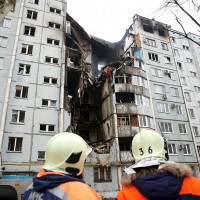 How gas explodes in an apartment: causes of explosions and tips for safe use of gas
How gas explodes in an apartment: causes of explosions and tips for safe use of gas 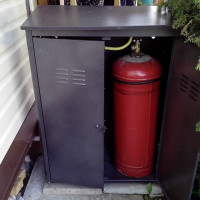 Gas cylinder gasket: what is it used for, typical sizes, replacement instruction
Gas cylinder gasket: what is it used for, typical sizes, replacement instruction 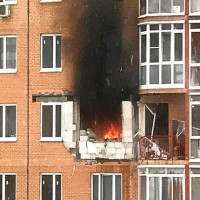 Why gas cylinders explode: root causes and preventive measures
Why gas cylinders explode: root causes and preventive measures 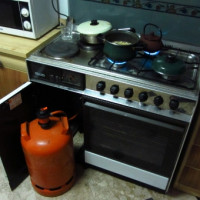 Is it possible to keep a gas cylinder in an apartment: rules and regulations for the use of balloon gas
Is it possible to keep a gas cylinder in an apartment: rules and regulations for the use of balloon gas 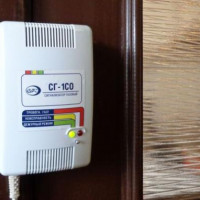 Gas leakage sensor with shutoff valve: device, classification + how to choose and install correctly
Gas leakage sensor with shutoff valve: device, classification + how to choose and install correctly  How much does it cost to connect gas to a private house: the price of organizing gas supply
How much does it cost to connect gas to a private house: the price of organizing gas supply  The best washing machines with dryer: model rating and customer tips
The best washing machines with dryer: model rating and customer tips  What is the color temperature of light and the nuances of choosing the temperature of the lamps to suit your needs
What is the color temperature of light and the nuances of choosing the temperature of the lamps to suit your needs  Replacement of a geyser in an apartment: replacement paperwork + basic norms and requirements
Replacement of a geyser in an apartment: replacement paperwork + basic norms and requirements